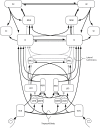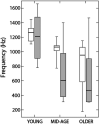Impaired Binaural Hearing in Adults: A Selected Review of the Literature
- PMID: 33815037
- PMCID: PMC8017161
- DOI: 10.3389/fnins.2021.610957
Impaired Binaural Hearing in Adults: A Selected Review of the Literature
Abstract
Despite over 100 years of study, there are still many fundamental questions about binaural hearing that remain unanswered, including how impairments of binaural function are related to the mechanisms of binaural hearing. This review focuses on a number of studies that are fundamental to understanding what is known about the effects of peripheral hearing loss, aging, traumatic brain injury, strokes, brain tumors, and multiple sclerosis (MS) on binaural function. The literature reviewed makes clear that while each of these conditions has the potential to impair the binaural system, the specific abilities of a given patient cannot be known without performing multiple behavioral and/or neurophysiological measurements of binaural sensitivity. Future work in this area has the potential to bring awareness of binaural dysfunction to patients and clinicians as well as a deeper understanding of the mechanisms of binaural hearing, but it will require the integration of clinical research with animal and computational modeling approaches.
Keywords: auditory; binaural; impairment; lateralization; localization; spatial hearing.
Copyright © 2021 Gallun.
Conflict of interest statement
The author declares that the research was conducted in the absence of any commercial or financial relationships that could be construed as a potential conflict of interest.
Figures












References
-
- Abel S. M., Giguère C., Consoli A., Papsin B. C. (2000). The effect of aging on horizontal plane sound localization. J. Acoust. Soc. Am. 108 743–752. - PubMed
-
- Akeroyd M. A., Whitmer W. M. (2016). “Spatial hearing and hearing aids,” in Hearing Aids, eds Popelka G. R., Moore B. C. J., Fay R. R., Popper A. N. (Cham: Springer International Publishing; ), 181–215. 10.1007/978-3-319-33036-5_7 - DOI
-
- ANSI/ASA S3.6 (2018). Specification for Audiometers. Melville, NY: Acoustical Society of America.
Publication types
Grants and funding
LinkOut - more resources
Full Text Sources
Other Literature Sources

